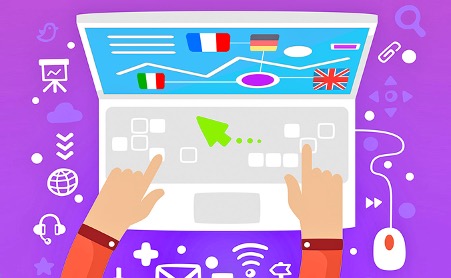Expanding your business into different markets is an exciting step to take. In order to maximise your chances of success, it is crucial that your website offers your new target audience what they need.
This isn’t merely a case of translating your website’s content into the relevant language. Creating the right tone, making the content accessible and showing an awareness of cultural norms are all integral parts of making sure your multilingual website attracts visitors. Once there, it’s essential to create content that will keep those visitors on the page long enough to engage with your products or service.
Make your website user-friendly
The first thing your potential new customers from a different country will want to see on your multilingual website is their own language, or the button to select it. This needs to be carefully positioned. In languages which read Left-to-Right, which includes most European languages, the icons should appear in the top right-hand corner of your site.
Consider whether you want to use the language name or initials, or a more visual flag icon. Flags work best when you’re targeting a specific country. The language name or initials can work better when you’re targeting multiple countries per language. This is because flags depict a country, not a language.
Take culture into account in your translation
While machine translation – such as Google Translate – can be useful for looking up definitions of individual words, the nuances of a piece of writing need to be translated by a living, breathing translator. Experts not just in the subtleties of language, translators are also skilled writers in the target language, so you will end up with a finely crafted piece of writing, rather than a cobbled together collection of roughly translated words, which may or may not make sense!
What’s more, translators understand the cultural significance of what they are translating. What might be appropriate to one culture, may be completely out of the question somewhere else. Gauging what’s appropriate, as well as selecting the perfect word or phrase will pay dividends in the long run. After all, what’s the point in spending time and money creating a multilingual website, only for it to come across as unprofessional – or even inappropriate in your target country?
Check your special characters
This is something that often comes up when English-speaking companies want to expand into countries whose languages use special characters, such as accents, umlauts – or even a whole different alphabet. This might necessitate a whole new font change, as well as making sure the text works in all of the languages your website will use. Using a Unicode-based encoding allows websites to operate in several different languages, although you may need to look carefully if you are also incorporating non-Latin fonts.
Similarly, English is quite an economic language in terms of length of text. If you’re translating images or Metatags, consider giving your translators a maximum length for the translation. The French tend to add more connecting words to sentences, whereas Germans use particularly long words combining several concepts together, for example. Your translators need to work with your designers to be sure that all versions of your website work. See https://www.w3.org/International/articles/article-text-size for a guide on the average lengths of texts in different languages.
Prioritise SEO
When you create translations of existing content, you need to make sure there are as few duplications as possible. If you have pages with duplicate content, you risk keyword cannibalization – this is where multiple pages might rank for the same keywords and you are effectively competing with yourself.
It’s particularly important that your website doesn’t use the same content as other sites. Google don’t consider a translation itself to be duplicate content.
Another thing to check is that every language has its own unique URL. If when you navigate between languages, the URL doesn’t change, Google will only index a single version of your site, meaning you won’t rank for more than one language.
SEO falls into 3 main categories:
- Content – Is the content engaging, relevant, unique and well-written?
- Technical SEO – This includes a myriad of factors including Metatag Titles and Descriptions, page speed and UX. For multilingual sites, you can add Hreflang tags and canonical URLs to control which language Google recognises each page as, and whether the checkout process is flawless for all your target countries.
- Quality backlinks – It’s essential that you have backlinks from trustworthy sources for each country you want to rank in. If you translate a website that ranks well in English, but don’t build any foreign language links, it will continue to rank well in English, but not in the new languages.
It is always worth enlisting the services of a specialist multilingual SEO agency like https://www.indigoextra.com to guide you through the process. They can carry out multilingual SEO audits as well as website translation to help you get your feet off the ground and, most importantly, make sure your website can be discovered by search engines. You could create the most fabulous website out there, but if Google doesn’t list it, there’s sadly not much point.
Creating a multilingual website is exciting; watching your company grow outside of your own country, embrace new cultures and reach people from different places is an exhilarating process. Don’t be daunted by the things you need to do, though; simply follow these tips and you will soon have visits to your site from all over the world




